Key information for tourists :
- Distance from Mahabaleshwar: 25 Kms
- Entry fees: FREE
- Timings: 7 AM to 6 PM on all days
- Guide services are available with a nomimal fees of ₹300/- paid at the counter.
- Guides do not expect a Tip, however I prefer to do so for enlightening me for infomation not available in the history books
- Umbrella is available on hire, for rain or the Sun
- Best time to visit: October to April
- Duration: Upto 2 hours
- Total stairs to the Top- 450
Facts about the Fort
- The fort was inaugarated 1656
- Shivaji entrusted the task of Moorpant Trimbak Pingle (Prime Minister) to construct this Fort
- The current owner is Udayanraje Bhonsle
- The Fort is divided across the Upper and Lower levels.
- In this blog, I will describe my journey from the Lower to the Upper Level
- There is a parking spot which can accommodate about 40 vehicles.
History of Pratapgad:
The Pratapgad fort is synonymous with the Battle of Pratapgad where Shivaji Maharaj outwitted Afzal Khan during a truce meeting. This victory is spoken of as the turning point and the beginning of the glorious days of the Maratha Empire. In 1674 he was formally crowned the Chhatrapati in his capital fort of Raigad.
Shivaji was the son of Shahaji Bhonsle who was a General who served the Ahmadnagar, Bijapur and the Mughal empire during the various points of his career. Finally, he was the Chief General of the Bijapur dynasty and oversaw the growth of the dynasty. He passed away in the year 1664.
There is no doubt Shivaji was a genius when it came to the art of warfare and we can writes pages about his acumen and skills demonstrated over his career. Notwithstanding my respect for Shivaji grew multifold when I realised he was the first to form a Naval army and his forts on the sea and overlooking the Sea is a testimony of this fact. He actually played the game of the Dutch and the English and was instrumental in controlling the sea routes for years to come.
Shivaji started acting independently and gained control of the Mahabaleshwar region. The Bijapur Sultanate was naturally infuriated by this development. Shivaji not only managed to win over other subordinate territories of Bijapur but also negotiated with Aurangzeb who was raging a war with Adil Shah of the Bijapur dynasty.
As they say, Politics can be unpredictable and that is exactly what happened when Adil Shah negotiated a truce with Aurangazeb. Finally, the dark cloud of worry floated away from the Bijapur dynasty allowing them to focus their attention to exterminate Shivaji and his empire. In 1659 the task was entrusted to Afzal Khan who was the most revered General of the Bijapur Government.
In April of 1659, Afzal khan started his march from Bijapur with a formidable army at his command. He wanted to have an open fight with Shivaji in the plains because his infantry strength was much superior to Shivaji’s. However, an adroit Shivaji played various propaganda and tricks to avoid a direct confrontation frustrating Afzal Khan.
Shivaji continues to eschew till the Monsoon hit the subcontinent and providing a 4-month window to strategies fo the future. It was impossible for Afzal Khan to start a war in the hill and that too when the skies opened its fury to the ground. The stalemate resulted in Afzal Khan proposing a truce meeting at the foothills of Pratapgad Fort on 10th November 1659 ( Some historian claims 20th November 1659)
It was crystal clear to Shivaji that Afzal Khan will use this opportunity to eliminate him. In spite of this, he agreed to the meeting and decided to take the bull by the horn. Each side was allowed to bring in 10 warriors and Shivaji chose his men wisely.
It was customary at the point of time to embrace each other as a greeting before a meeting. Afzal Khan was a giant of 6 Ft 7 inches and planned to chokehold a middle heightened Shivaji during this customary embrace. He also concealed a dagger in his coat as a contingency measure. He was confident of his ability that he did not bother to anticipate what Shivaji might come up with, which ultimately led to his downfall.
As soon as they embrace Afzal Kahn used his vice-like grip to suffocate Shivaji and brought out the dagger that pierced it on Shivaji’s chest. Probably he was visualising the lifeless body of Shivaji when he would have felt excruciating pain on his stomach. Shivaji came prepared with body armour and a Bagh nakh( indigenous weapon in the shape of a tiger’s claw) on his fingers. He accurately anticipated the flow of the event and used the Bagh Nakh and disembowelled Afzal Khan.
At this point one of the bodyguards( Sayid Baanda) of Afzal Khan attacked Shivaji but he was killed by an alert Jiva Mahala who accompanied Shivaji to the tent. Afzal Khan used this opportunity to run out of the tent but he was easily captured and beheaded. There are other versions of this event but I wrote what I believe is true basis of my judgement.
Should we visit during the Monsoon?
Monsoon is definitely not an ideal time to visit Pratapgad. Apart from the history, tourists flock here to witness the spectacular views of Mahabaleshwar and the valley from 3500 Ft above ground. During Monsoon it is practically always shrouded under cloud cover making it unpopular to most.
However, I had to experience the rains to concede why it acted as a deterrent to Afzal Khan to stop his invasion for 4 long months with a huge army at his disposal. And boy, the downpour brought about the despondency of not being able to manage an umbrella! It made me contemplate the force required to carry arms and ammunition up the slope. Just not impossible.
It should not be interpreted as an intrepid act because the roads in India are much better than in the past. While landslides are common during this time, it has not caused a significant setback over the years. Importantly, I was taking this journey to pay my obeisance to one of the greatest generals of India and thus demonstrating a bit of courage is the least I could have done.
Let us not forget the joy of driving in the Indian Monsoon in a greener surrounding. When the rain stops momentarily I roll down the window and catch the clean air which is seldomly available in other seasons. I have tried to reason from my perspective and readers are advised to make their informed decision basis their preferences
The Vantage Point of the Fort- 14th July 2021
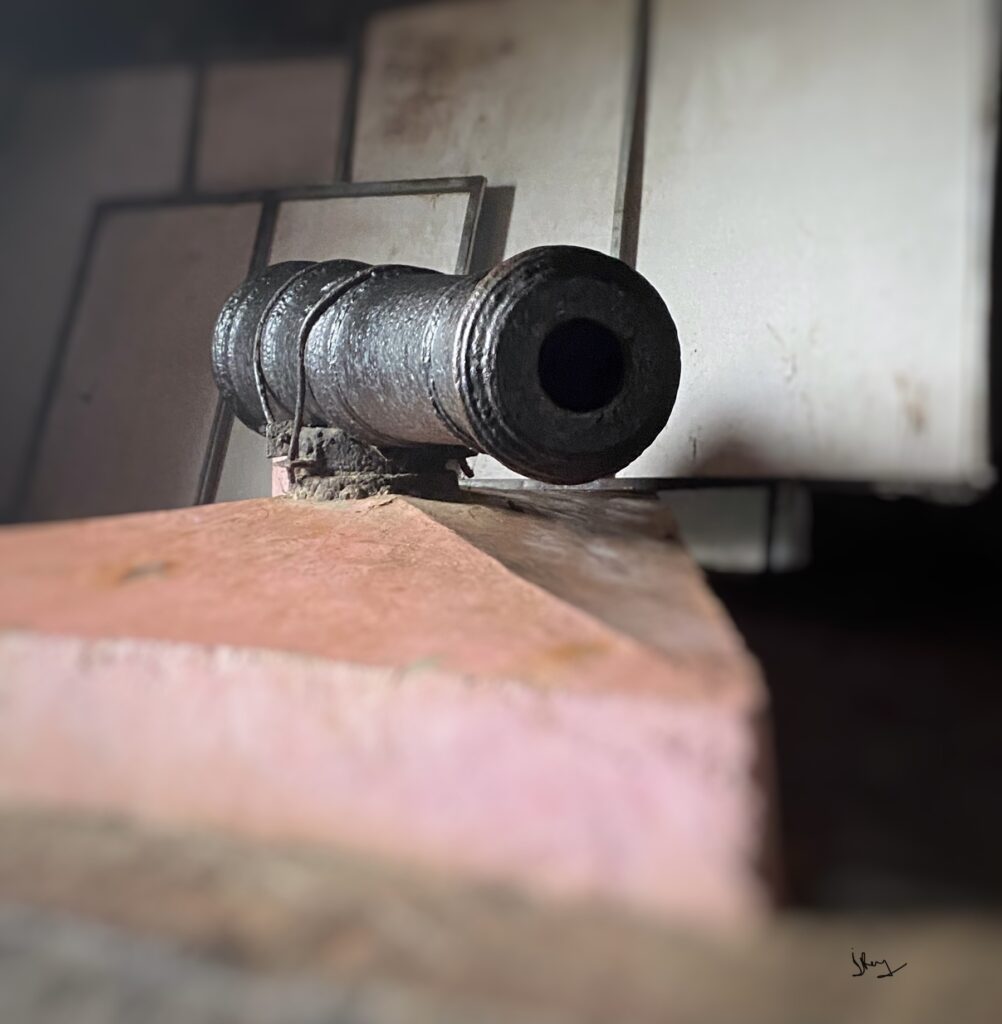
During the 17th century, the entry to the Fort was through a tunnel at the foothills of the mountain. This primary route was accessed by the soldiers and the inhabitants of Pratapgad Fort. It is located on the left side of the Staircase which leads to the entrance gate of lower level of the Fort. I would request the curious souls to avoid venturing inside the tunnel it can be a good shelter point for reptiles during the wet season. Importantly it is sealed after a point and cannot be accessed anymore.
Besides the tunnel, a feeder lane (accessible by feet) can be seen going deep inside the forest and down the mountain. In ancient time the road was marred by dangers of wild animal attack and thus people used to tarverse in large groups. But, this also ensured protection from an armed assault as it was practically unthinkable for an army to march up this road.
To my utter surprise, Balakrishna Jadha (my guide) remarked that even today villagers seldom use the road in the daytime. Looking at the discocerted look on my face he smiled and clarified that this route continues to be the fastest route on foot. Thankfully we now have motorable road and I am grateful to have a car! From here on I will call my guide as Bala whose knowledge, humility and manners made him a friend and my heart grew a predilection towards him.

Bala suggested that we now walk towards the Entrance of the main fort and I followed him obediently. We climbed 95 stairs to the Entrance gate and the path seemed quite narrow for a cavalry movement. Bala clarified that the stairs were built in 1957 for our First Prime Minister of Independent India who visited to inaugurate the Bronze statue of Shivaji Maharaj. Rocks identical to the fort walls were used to bring in symmetry with the structure of the fort. In ancient times, the lane to the Fort was rugged land without any laid pathway.
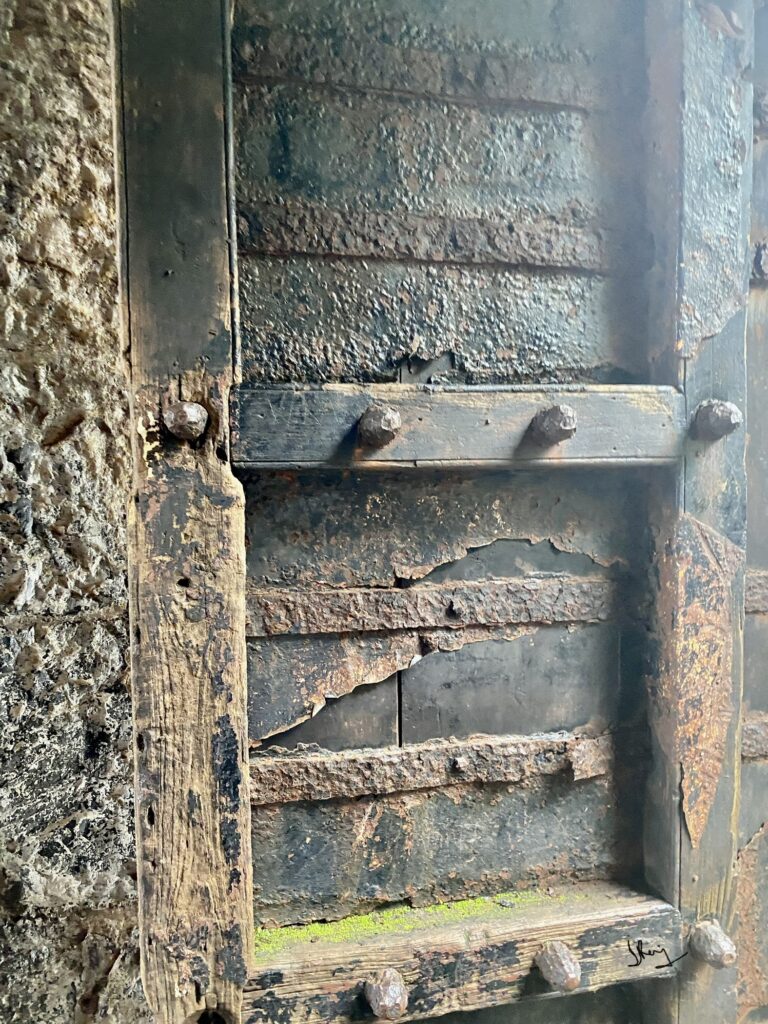
The lane was narrow on purpose to make it difficult for the enemy soldiers and the Elephants to attack the gate. There were iron rods on the Gate to ensure elephants cannot charge in with their head. On a closer look at the boundary walls, I could spot several openings for Cannons to fire at the enemy
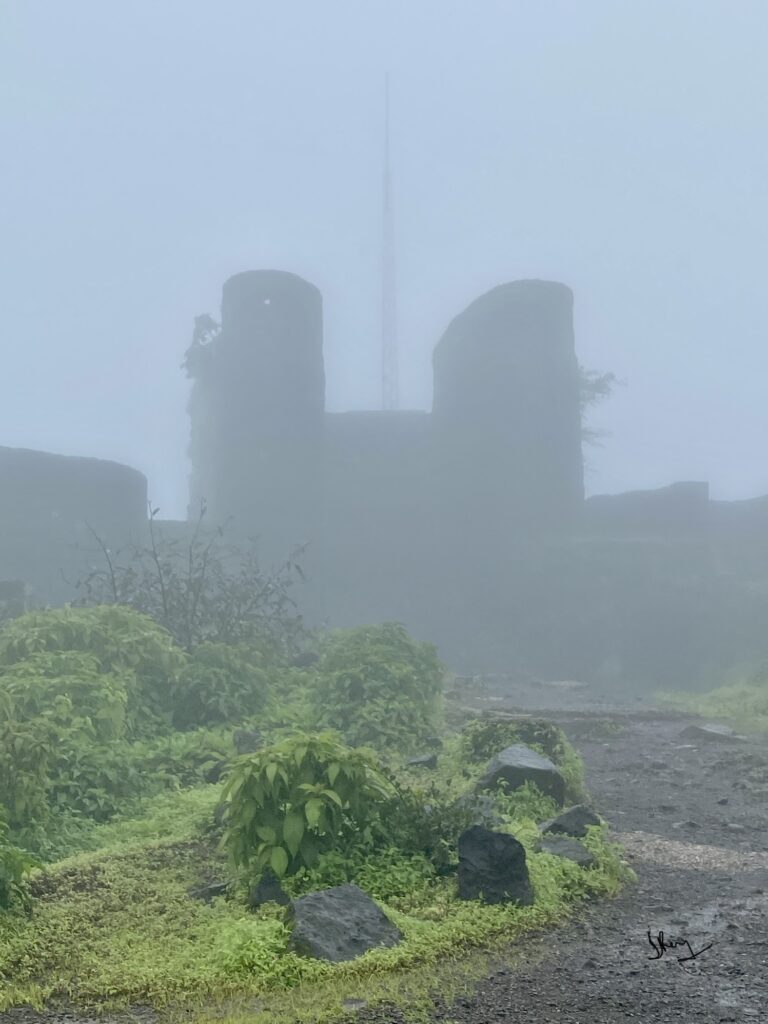
As we walked straight 30 metres from the entrance I encountered the magnificent tower of Pratapgad Fort as seen in our history book. Unfortunately, owing to the cloud cover I could not get a clear shot. The ill effects of Monsoon!
It was a dead end thus we turned back and started walking backwards beside the boundary walls. The view fro this point brings flocks of tourists to the fort. During the season the mountains of Mahabaleshwar and even Rajgad fort can be seen. That day there were hardly any tourists and zero visibility as the Clouds invaded the Valley down. Notwithstanding,t he strong winds on my face was a constant reminder that I am 3500 Ft above the ground.
My chivalry staring at the wind did not last long as the skies opened up with sheer force. I caught sight of a small makeshift tent and sprinted to take cover. It turned out to be a storage for Limestone leaving me bewildered of its purpose. Bala understanding my ignorance volunteered to explain that Limestone is an alternative to Cement. Cement was not available in the 17th Centuryand thus Lime mixed with Honey was used as a binding material to keep the rocks together.
Presently the Government is using the same method to conserve and maintain the Fort and therefore Limestone is stored. In his eagerness he showed me the machine used to mix the materials and expounded the entire workflow. I was delighted to learn this because this question of how the stones stayed together vexed me for so long!
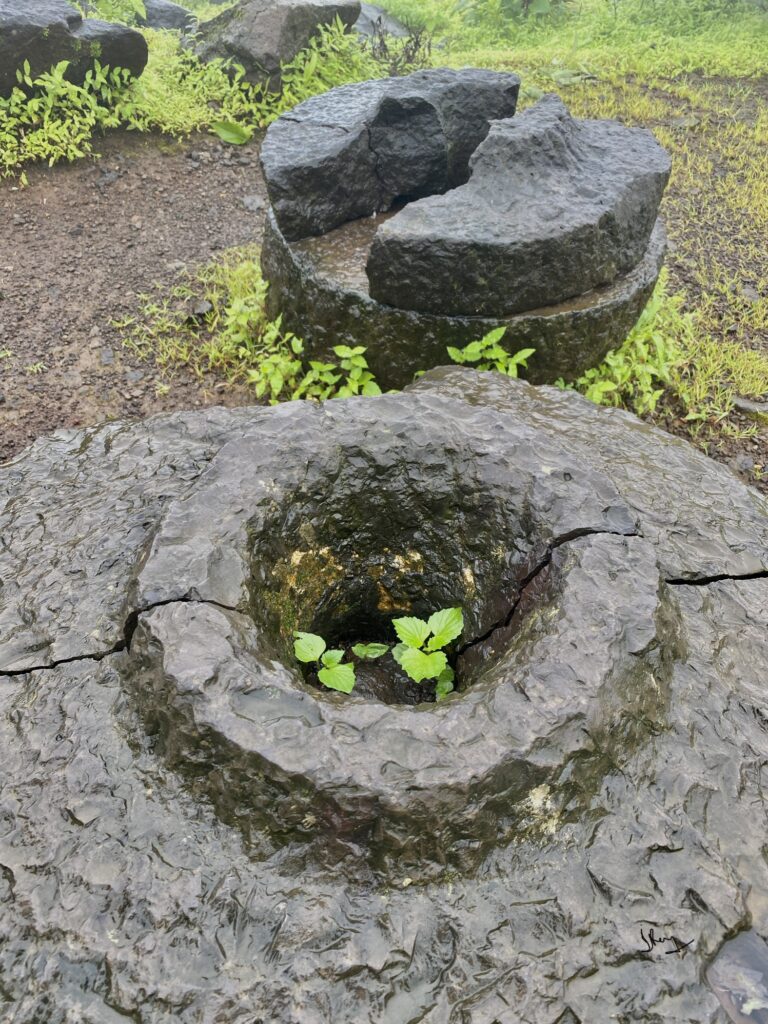
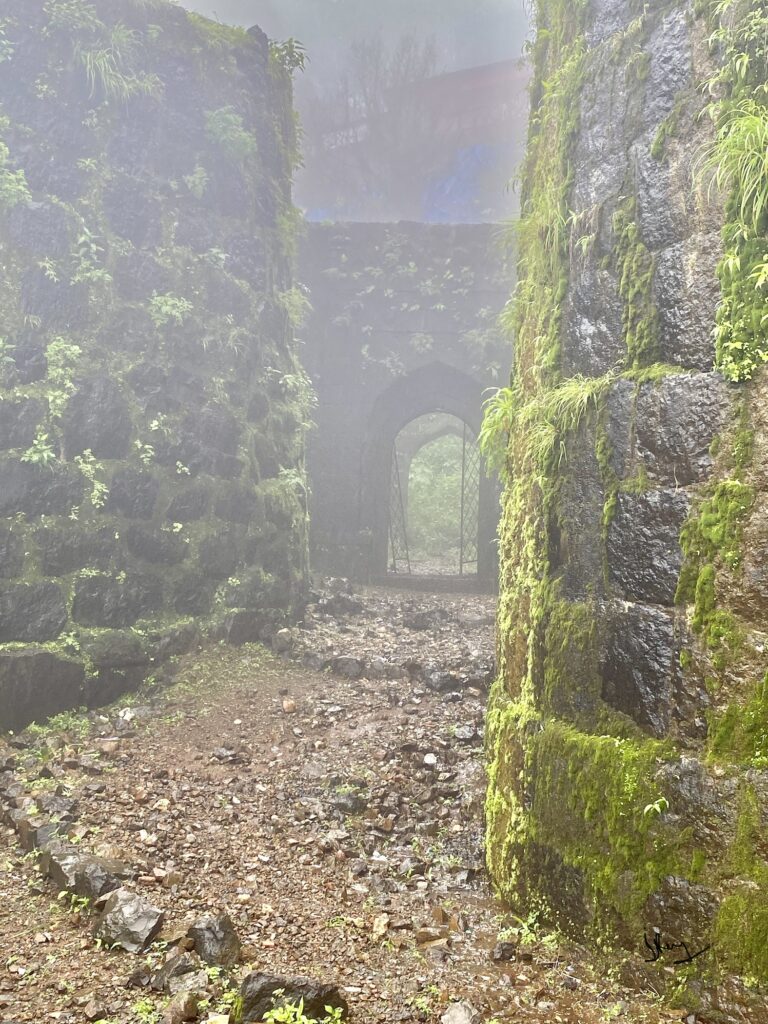
The rain retarded, as Bala completed his monologue and we moved back on our track, ascending past the main gate and beyond it. Bala pointed towards a small Gate on my left side just before the stairs lead to a large Pond on my right side. The inconspicuous Gate covered with vegetation looked grubby, in spite of the rain.
Shivaji was a devout believer of the Bhavani and visited the Tujla Bhavani temple inside the fort. He came on horseback up to this gate and then carried on a Palanquin to the temple by the owners of the Fort. This passage was exclusive for the Maharaja and was a mean to shower respect to him. It was impossible to imagine that this furtive gate was a testimony of history unless otherwise explained by Bala
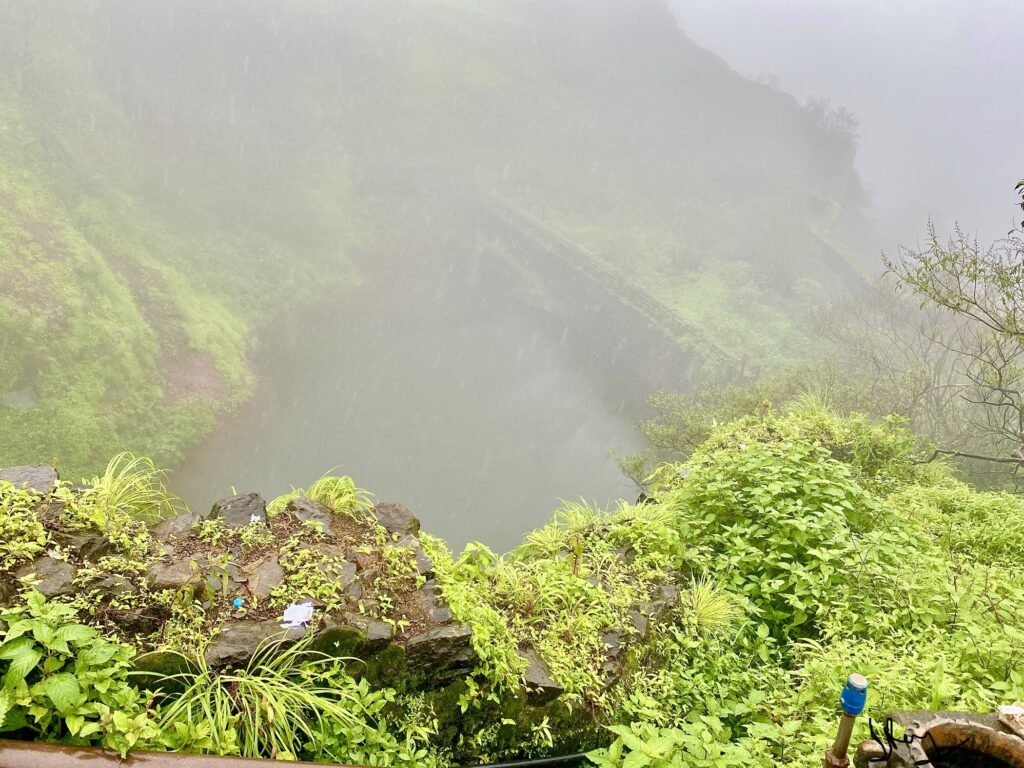
Being a commoner I continued through the staircases and halted on seeing a large Pond. To built any Fort a lot of Rocks are required and Pratapgad was no exception. The soil was dug to collect necessary stones at a point where rainwater will flow down and create a reservoir for fresh water.
The stairs become quite steep from this point and takes a right turn towards the Bhavani temple. The tomb of the temple caught my attention followed by the water outlets from the temple. These outlets are decorated in the form of animal faces. In the temple yard different canons and unique arms were displayed too. I sat down for a while observing these unique arms and trying to feel the pious and positive energy all around.
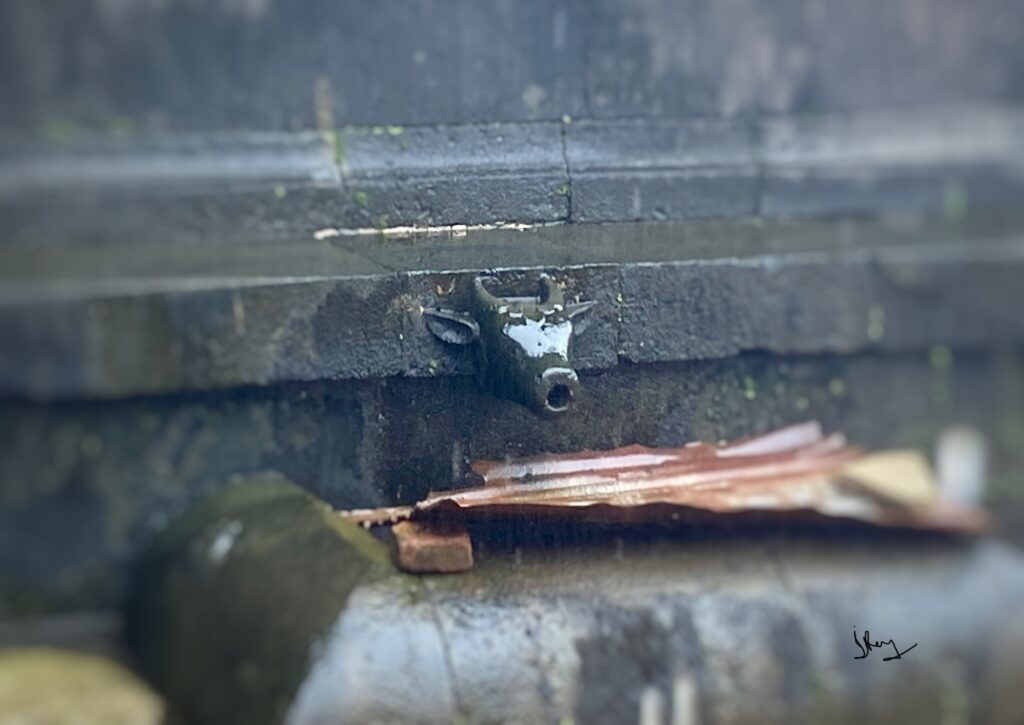
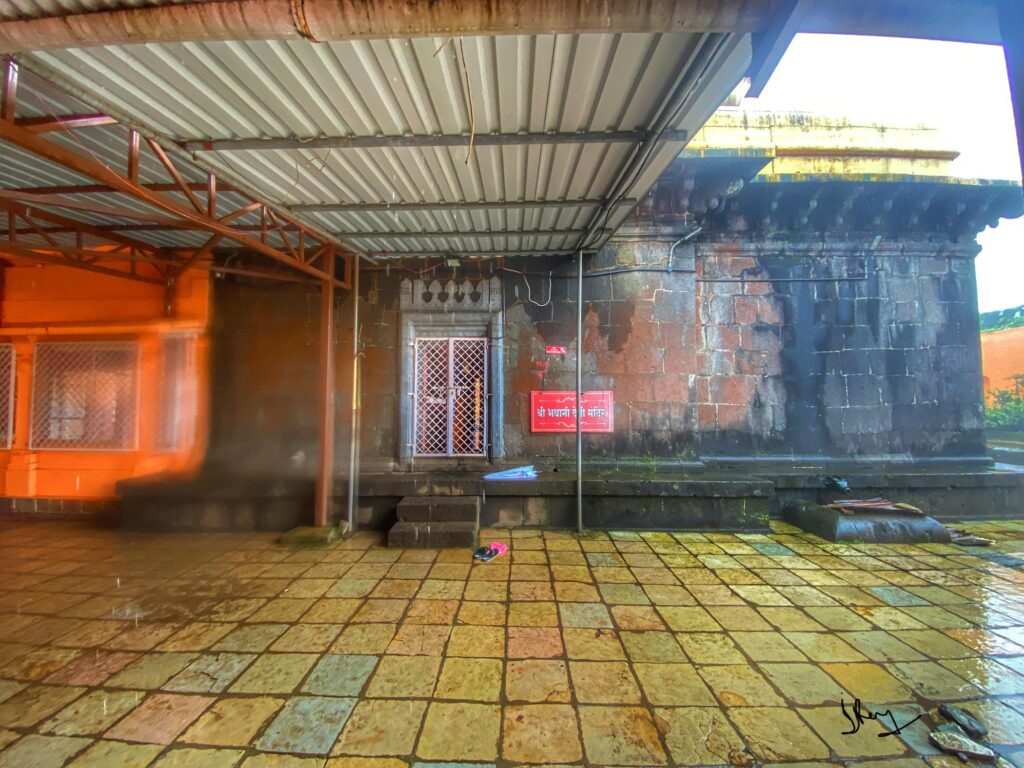
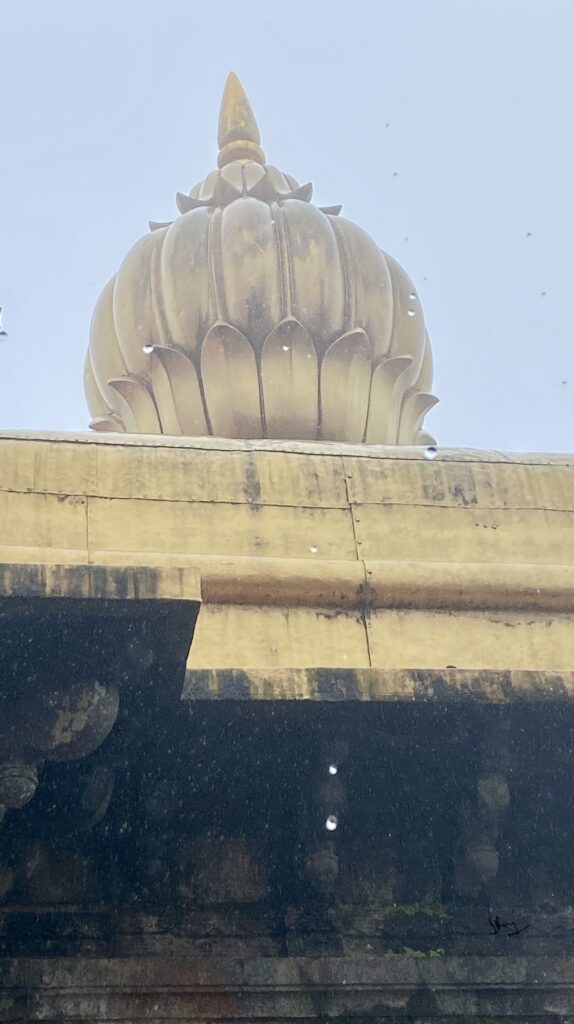
After paying my reverence, we continued our ascend towardsUpper Level passing by a row of houses and shops. The rain resumed back with its fury and Bala enquired if I desire a tea and snack break. I politely declined but Bala was insistent on the snacks given the weather. He informed me that he stays with his family inside the fort and his wife runs a tea shop. I laughed out loud and coaxed him to carry on without a break.
There are many families like Bala who stays inside the fort. Their forefathers were soldiers and they continue to stay back on this land. Migrants like me will probably never understand the value of Mother Earth. But, interacting with Bala I realised they are connected to the soil. The spark in his eyes was visible whenever he spoke about the glorious past of this wonderful fort.
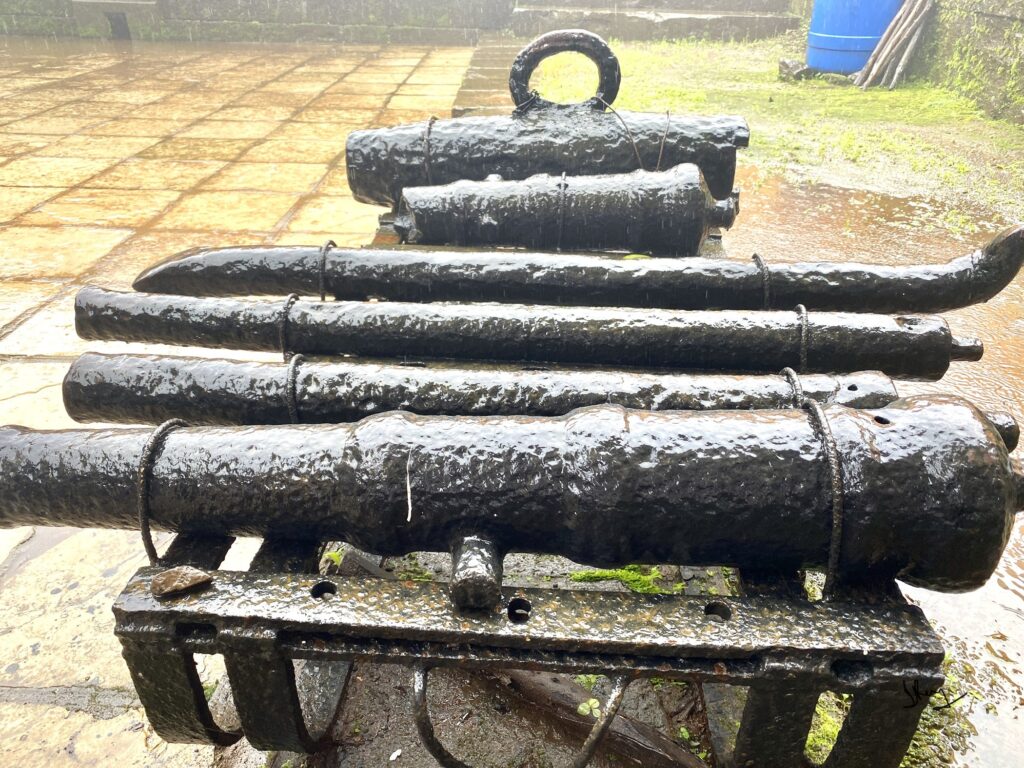
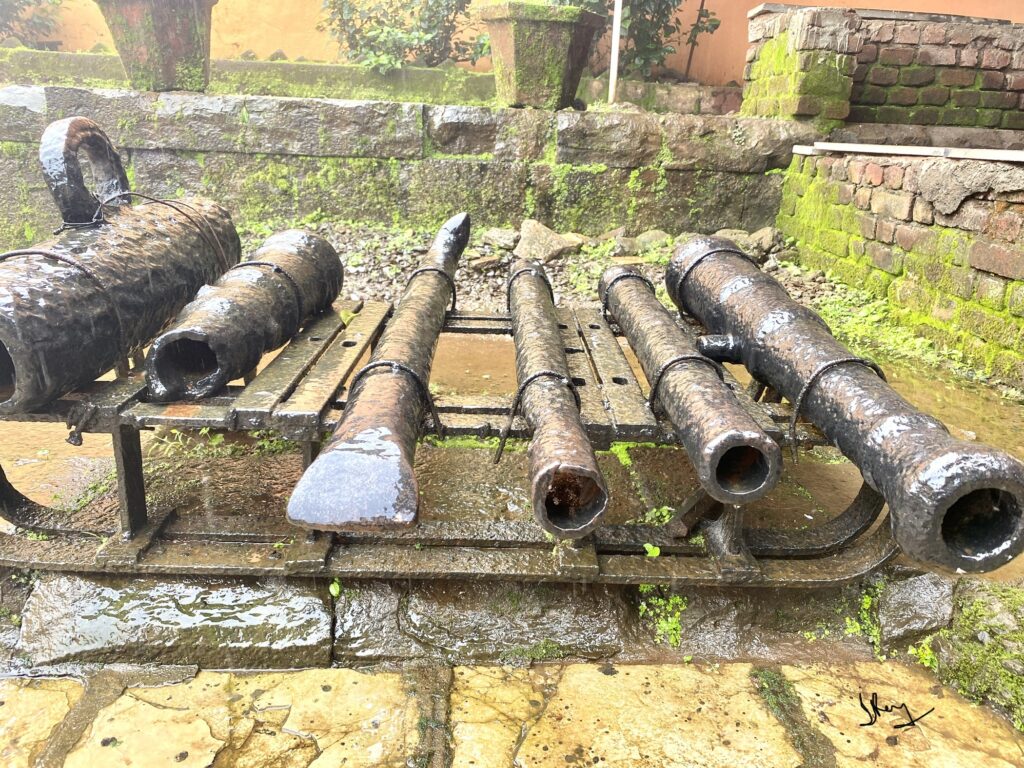
About 150 steps further we reach the Upper level of the fort where the first stop is the Shiva temple. It had an open courtyard in front and had a huge administrative importance. Anybody willing to show their alliance were asked to take an oath and prove their mettle in the open courtyard.
Walking past the Temple I continue walking and came across a Watchtower. The clouds decided to amuse me for a few seconds with an unadulterated view of the mountains from the top. It was so sudden and unexpected that I failed to capture it through my camera. I decided to wait for a few more minutes with my camera in my hand ready to shoot. Alas, there were no second chances
A little ahead Bala pointed towards a tunnel going downwards. The rain water was flowing down the stairs and at a glance looked quite slippery. I curiously looked towards Bala and he understanding my dilemma gave an affirmative nod of his head. With alacrity in my heart, I moved 15 steps downwards reaching an outlet into the mountain. The wind was very strong at this point.
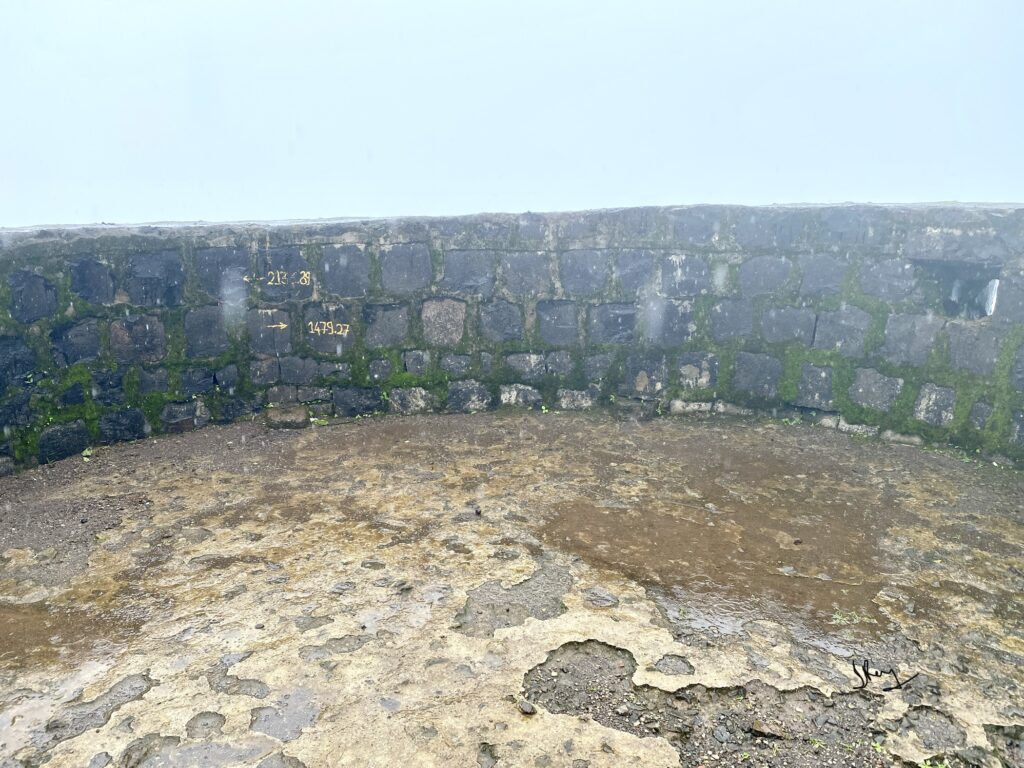
I held on to the wall with my right hand and protruded my neck as far as possible and looked down. I was completely engrossed with the view when a lizard jumped on my shoulder, hopped to my feet and vanished in oblivion . This innocent act brought the daylight out of me and I let out a shrill shriek out of my throat. This resulted in momentarily losing my balance and my body moved to an angle which allowed me to spot a walking trail going down the mountain.
Thankfully I was happy with the outcome and didn’t want to experience another encounter with a Reptile. Thus, I scampered back to the top where Bala was waiting for me. He explained that this was an contingency route for the soldiers if the fort falls into the hand of the enemy. The walking trail now made sense to me but with all gravity I remarked, “You should allow tourists to go down unattended”
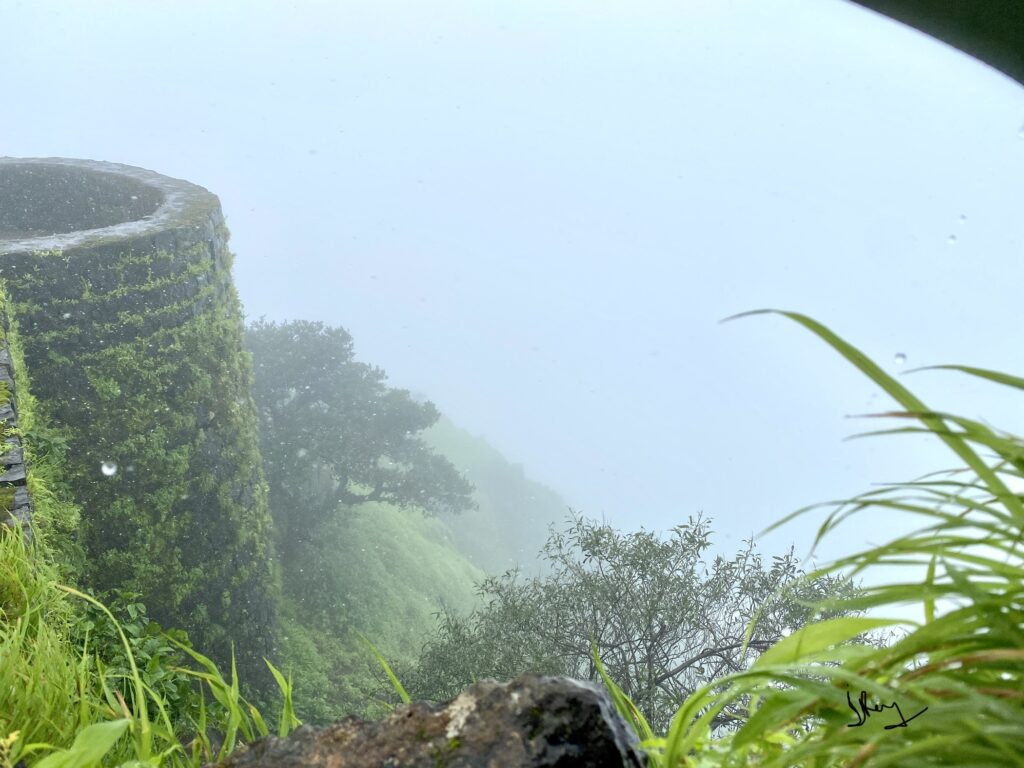
Bala had an intrigued look on his face but he decided to let it pass. He started walking beside the boundary wall and I followed him fully chary to avert another incident of a Lizard using me as a launch pad. My eyes remained fixated on the ground and about 20 metres I noticed that Bala has stopped at a point. He was standing on my right and as I looked up I saw a huge Statue of Shivaji Maharaj.
I was about to walk towards the statue but Bala stopped and pointed to a view point exactly behind me. This spot was built as a Punishment point to throw away the Traitors down the mountain. Thankfully, it remained virgin as nobody betrayed the Maharaj ever. Bala requested me to look down the boundary wall but I decided against. After encountering the chilling feeling of looking down this height( moment back) I was in no mood to go near the walls.
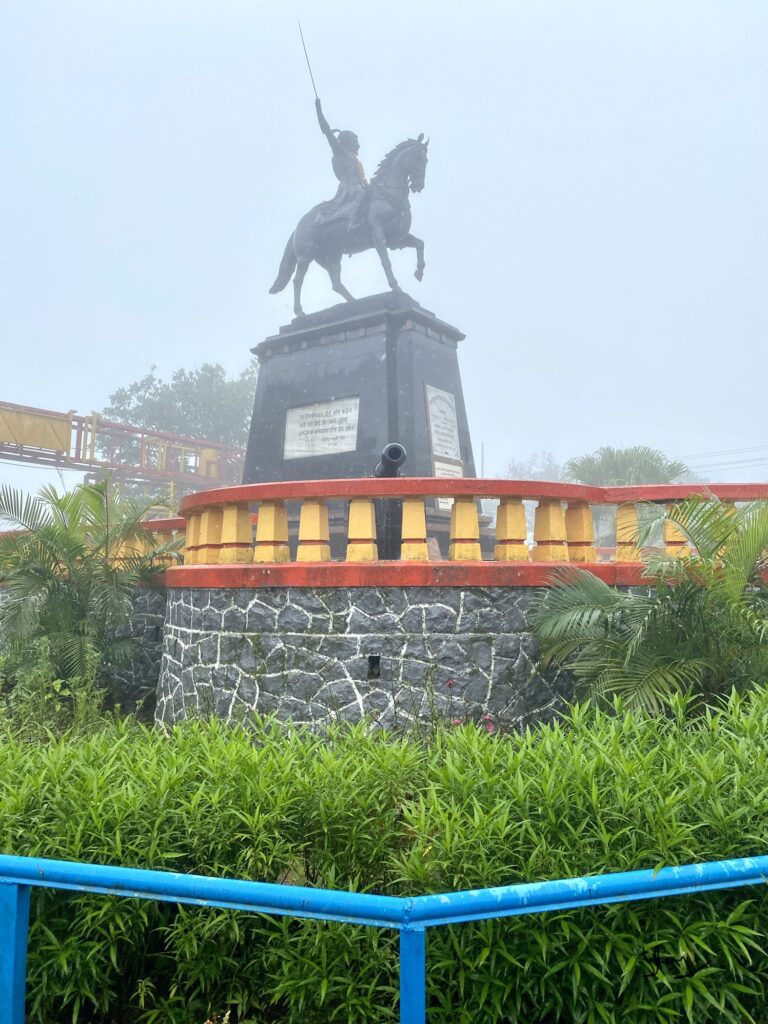
The final destination is the beautiful 17 Feet statue of Shivaji Maharaj riding on his horse Krishna. This statue was inaugurated by Pandit Jawaharlal Nehru on 30th November 1957. The entry inside the podium is prohibhited and reverence to be paid from outside. Krishna is seen with one leg up in the air which denoted that Shivaji Maharaj died of natural causes. As per the legends, a horse statue with both the front hooves in the air signifies that the rider has died in the battlefield.
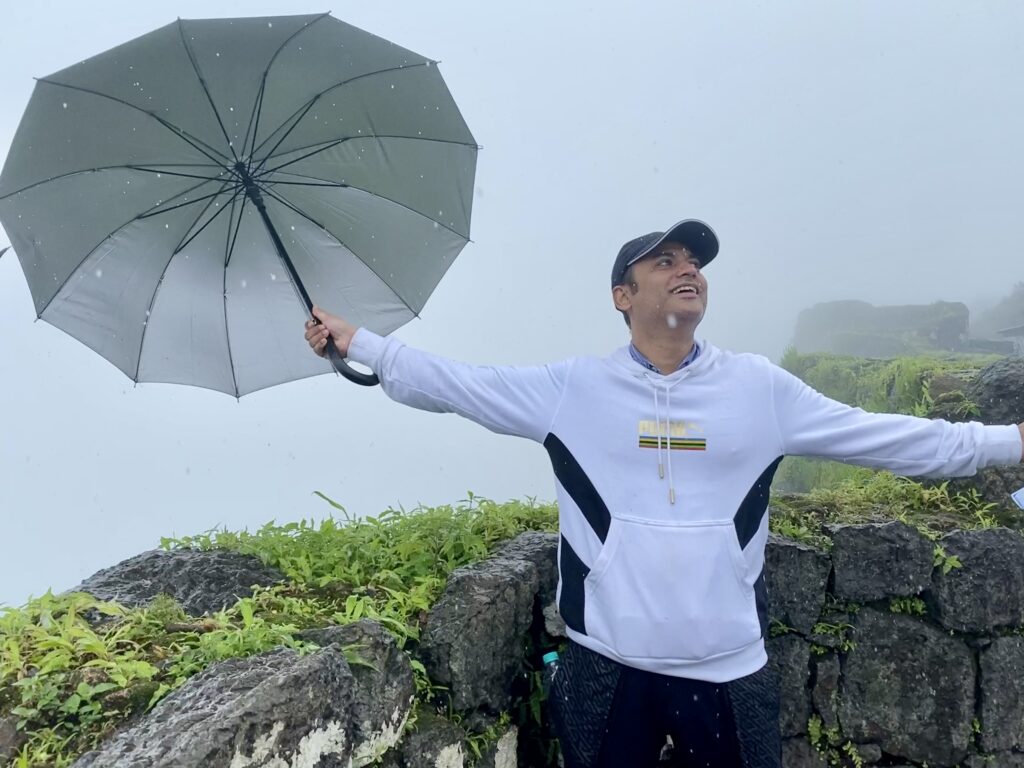
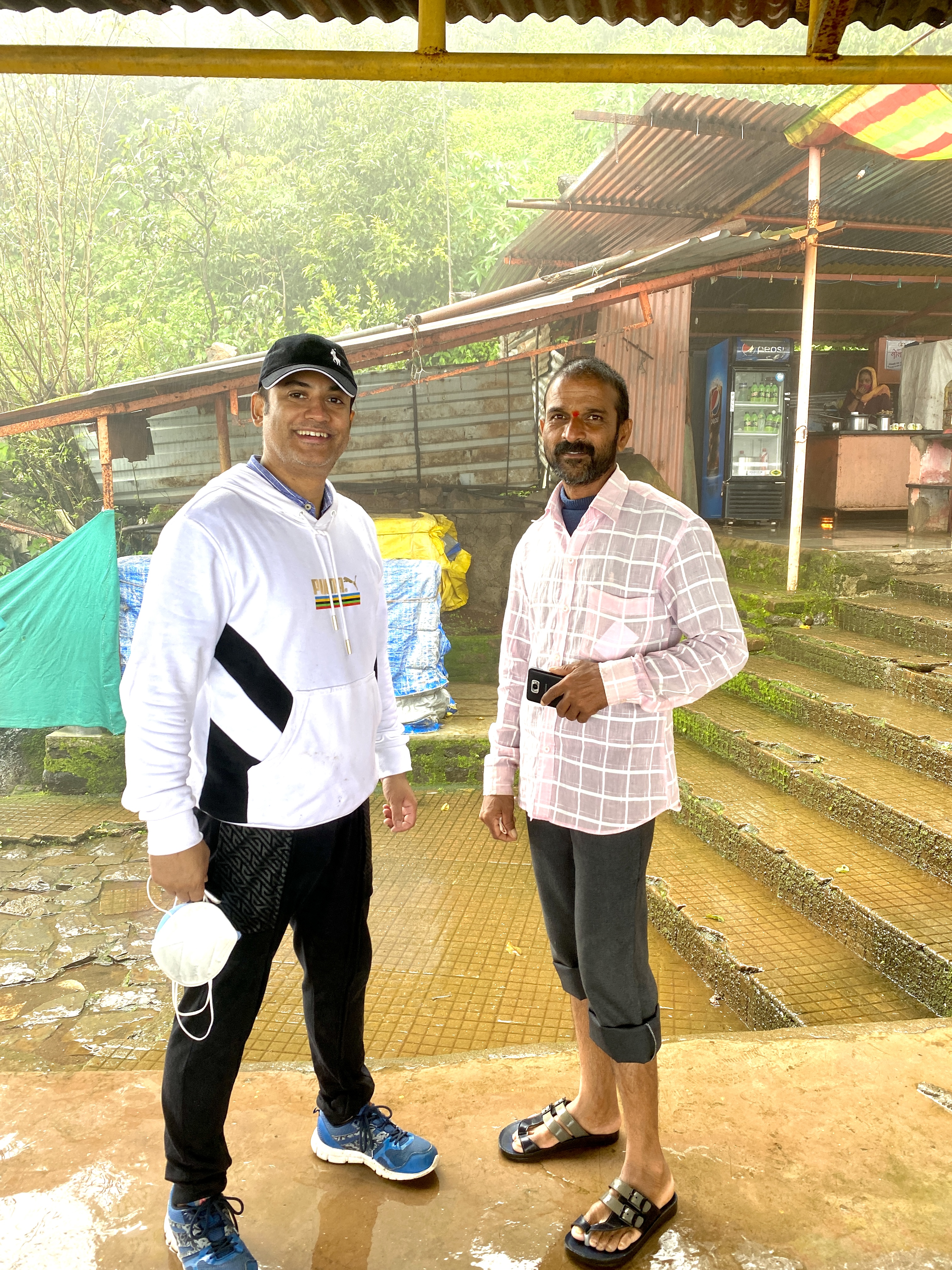
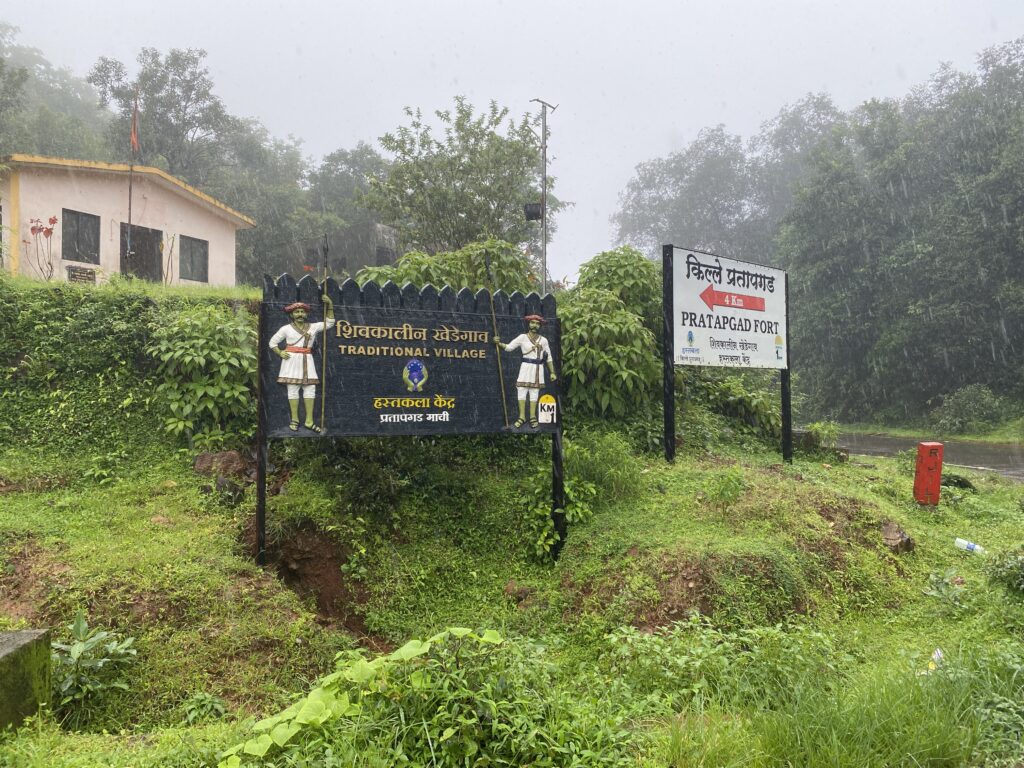
Requesting all of you to be careful and do not take undue risk while trekking in the fort during the rainy season. While I narrated it humorously the recollection of the incident does send shivers down my spine.
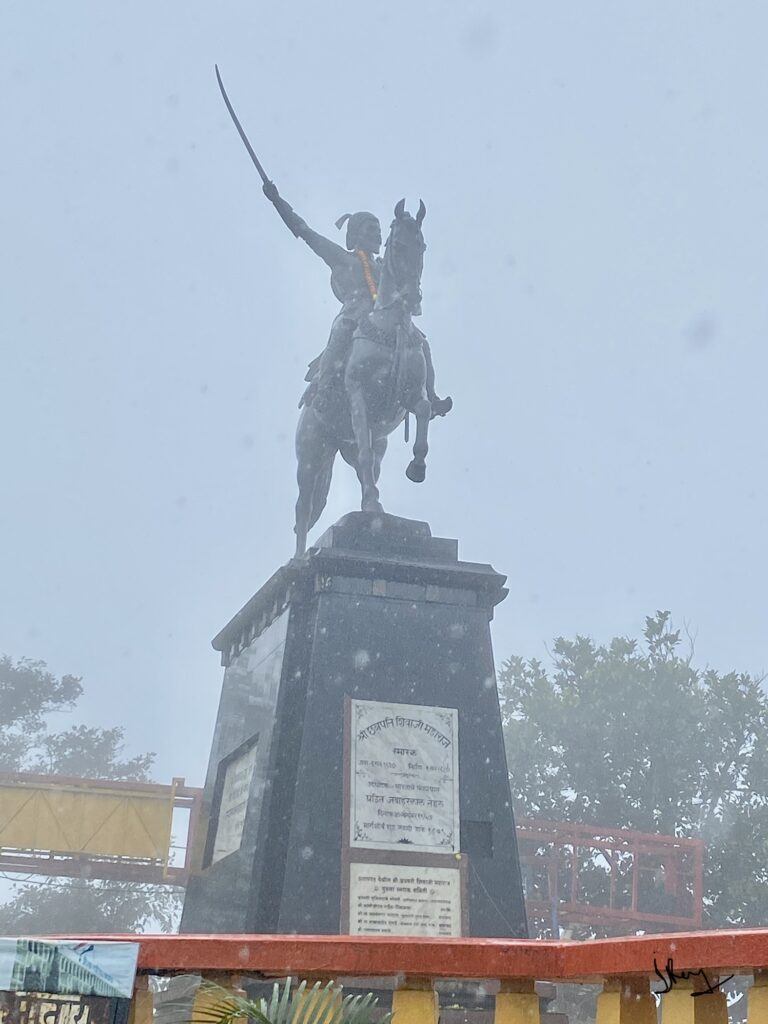
If you like my blogs please do sign up in my website for the Newsletter. I am moving on Shivaji’s trail to the next destination at Bankot. I hope you will come back to read it and enjoy it. Ciao !













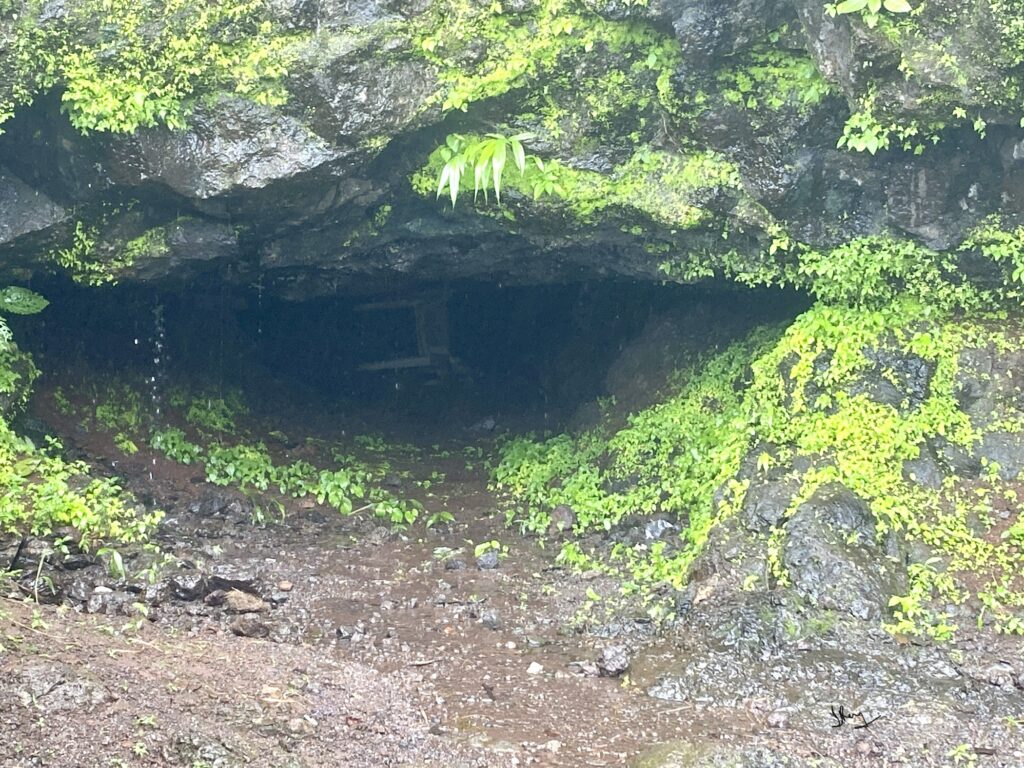








Metrotter very well written. Blog really gave me a visual tour and I felt I am physical present over there. The lush greenery make me feel how clean the environment would be. 🍀🌱🌿. awaiting to read your Bankot blog.
Keep writing ✍️
Greetings! Very helpful advice within this article! It’s
the little chnges that produce thhe bigggest
changes. Thasnks a lot for sharing!
Comments are closed.